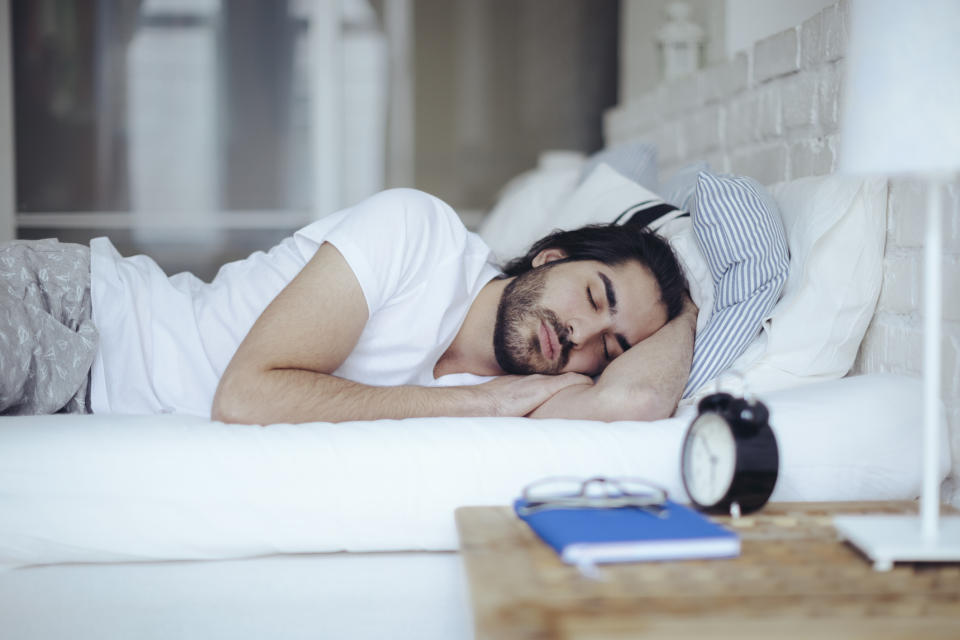Best sleep positions for common issues, from snoring to back pain

Sleep (or lack of it) is a pretty big deal right now.
From charting our zeds on our sleep app, to overhauling our pre-bedtime routine, sleep is something we spend a lot of awake time thinking about.
But while we’re busy trying to ensure our bedroom is the right temperature and our pillow is sprayed with magical sleep spray, we could be overlooking something else that can have a pretty big impact on our sleep quality: the position we sleep in.
Yep, according to sleep experts the position that you find yourself falling into most nights could actually end up causing you health problems, ranging from aches and pains to sleep apnea.
“Everyone sleeps differently but if you subconsciously fall into the incorrect sleeping position, neck, back and other muscle problems may become exacerbated,” explains Oliver Elliot, sleep expert at Nectar Sleep.
Read more: What to do if your child suddenly starts waking up in the night
Being able to adapt your body to sleep in a new position could actually be the secret to improving your sleep, or you could also try modifying your favourite sleep position to make sure you’re getting the most out of it.
“It's important to recognise your body's needs and try to adapt your physical positioning when trying to drift off to sleep, being mindful of tension in your body,” Elliot adds.
With that in mind Elliot has put together a handy guide to some of the most common sleep positions and how they might positively and negatively impact your snooze time.
Read more: 10 top-rated sleep products

Best for all round good sleep - The Baby
Also referred to as the foetal position, the Baby is the most popular way to sleep with around 41% of adults opting for this sleep position. In basic terms lovers of the baby tend to sleep on their side with their legs curled up underneath them. And as well as being the most popular the baby position causes the least amount of sleep interruptions and reduces the risk of neck strain, particularly if your mattress is quite firm.
Best for preventing premature wrinkles - The Sleepy Soldier
According to Elliot a person that sleeps in this position lays on their back with their arms straight down at their side – like they're standing to attention.
“The sleepy soldier allows the neck to rest in a neutral position, and decreases the chance for premature wrinkles,” he explains.
Anyone suffering from back problems may also want to try out the sleepy soldier as Elliot says it enables your weight to be evenly distributed, relieving pressure on the shoulders and spine.
Best for easing back and neck pain - The Log Roller
In order to pull off the log roller, the sleeper must rest on their side with their legs extended straight and has their arms in place.
“With your arms neatly at your side – in line with your body – the log roller can be great for easing back and neck pain as you keep both in proper alignment,” Elliot explains.
Read more: More than a quarter of children not getting enough sleep
Best for snorers - The Skydiver
The Skydiver involves people sleeping on their stomach, with their head to one side, and their arms wrapped around behind a pillow.
According to sleep.org 7% of adults are partial to some stomach sleeping, but it can lead to back and neck pain, mainly because it is hard to keep your spine in a neutral position.
Plus, stomach sleepers put pressure on their muscles and joints, which can potentially lead to numbness, tingling, aches, and irritated nerves.
“A king or a double sized mattress would suit this sleeper as you require space to spread out,” advises Elliot.
“While it can accentuate back or neck pain, it can ease snoring and sleep apnoea.”
Sleeping on your side or front can help prevent the base of your soft palate collapse to the back wall of your throat, causing that deep vibrating sound during sleep AKA snores.

Read more: People who nap are more productive
Best all rounder - The Yearning Dreamer
“To pull off this sleep position the sleeper rests on their side, but their arms are stretched out in front of them. Like the log roller, this position comfortably supports your back as it follows the natural curve of the spine.”
And it can also help improve snoring or those suffering from sleep apnea. Previous research has revealed that sleeping on your side can significantly reduce time spent snoring and the intensity of snoring.
But there is one downside. While 15% of adults choose to sleep on their side, this can lead to wrinkles, because half of your face pushes against a pillow.
Best for a great night’s snooze - The Shooting Star
If you like to take up all the room, the shooting star could be your sleep position of choice. “The Shooting Star involves lying on your back with legs stretched out and arms elongated up beyond the head, resembling a starfish.
“While this position can increase snoring, if you have the support of a great mattress – preferably a larger one to accommodate those outstretched limbs – you should find yourself sleeping sound and waking up as bright as a star.” *groans*



